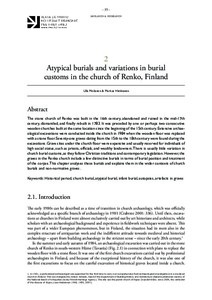Atypical burials and variations in burial customs in the church of Renko, Finland
Markus Hiekkanen; Ulla Moilanen
https://urn.fi/URN:NBN:fi-fe2021042822971
Tiivistelmä
The stone church of Renko was built in the 16th century, abandoned and ruined in the mid-17th century, dismantled, and finally rebuilt in 1783. It was preceded by one or perhaps two consecutive wooden churches built at the same location since the beginning of the 15th century. Extensive archaeological excavations were conducted inside the church in 1984 when the wooden floor was replaced with a stone floor. Seventy-one graves dating from the 15th to the 18th century were found during the excavations. Grave sites under the church floor were expensive and usually reserved for individuals of high social status, such as priests, officials, and wealthy landowners. There is usually little variation in church burial customs, as they follow Christian traditions and contemporary legislation. However, the graves in the Renko church include a few distinctive burials in terms of burial position and treatment of the corpse. This chapter analyses these burials and explains them in the wider contexts of church burials and non-normative graves. The early 1980s can be described as a time of transition in church archaeology, which was officially acknowledged as a specific branch of archaeology in 1981 (Crabtree 2001: 336). Until then, excavations at churches in Finland were almost exclusively carried out by art historians and architects, while scholars with an archaeological background and experience in fieldwork techniques were absent. This was part of a wider European phenomenon, but in Finland, the situation had its roots also in the complex structure of antiquarian work and the indifferent attitude towards medieval and historical archaeology-apart from building archaeology in the strictest sense-since the early 20th century. 1 In the summer and early autumn of 1984, an archaeological excavation was carried out in the stone church of Renko in southwestern Häme (Tavastia) (Fig. 2.1) in connection with plans to replace the wooden floor with a stone floor. It was one of the first church excavations carried out by professional archaeologists in Finland, and because of the exceptional history of the church, it was also one of the first excavations to focus on the careful excavation of historical graves located inside a church.
Kokoelmat
- Rinnakkaistallenteet [19207]
